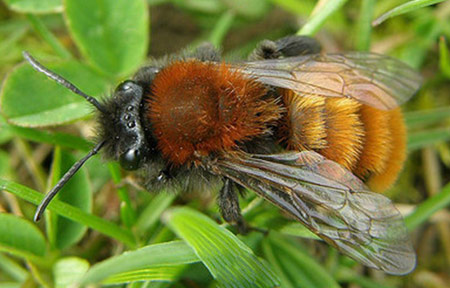A scarce Tawny mining bee, up until 2012 believed to have been extinct in Ireland for some 80 years, has once again returned in large numbers, some to appear on Co. Tipperary soil.

The Tawny mining bee had been last observed by Arthur Stelfoxin in 1925 just outside of Kilkenny and since then was believed to have gone extinct in Ireland.
In April 2012 Roger Goodwilliere reported, confirming he had observed this species in his garden, again in Co. Kilkenny, not far from where it had been last sighted, back in 1925.
Entomologists claim that the added growth of wildflowers, in public areas due to the failure by local authorities, to use poisonous weed killers; influenced by Covid-19 pandemic problems, lending itself to this increase in the bee’s population.
[Privately, Tipperary residents on the other hand believe the Tawney mining bee is leaving Co. Kilkenny, to migrate to the real home of hurling, following Tipperary’s 2019 All Ireland win.]
The female of this solitary species has bright, deep fox red hairs on its thorax (chest), with a more orange to red coloured hair on its dorcal surface (back). Their other ventral surface (underpart), i.e. legs and overall facial area are black haired.
The smaller, thinner male of the species are much harder to identify when compared with the female; as their hair is less dense and browner in colour. They display some long white hairs on their face; a tooth on each side of their mandibles (mouthpart) and without closer examination is passed off as our common honey bee.
They mate, requiring direct contact between the male and female, in spring, after which the male dies.
On a south facing bank or lawn, the female will build, in a short foliaged ground area, a nest with the entrance surrounded by a small volcano-like mound of excavated spoil. Perhaps their solitary existance in your area can be most easily identified from this small, volcano-like, telltale mound, if you are out cutting your lawn this week. Please do not upset it, rather view it as a gift to your garden and any plants, fruit bushes it may contain.
Here her nest will contain numerous brood cells in which she will lay one egg in each cell. Here also she will independently fill each cell with a mixture of nectar and pollen to sustain her larva, who will emerge the following spring after hibernation, long after their mother has departed.
If you are out and about taking exercise in your local park or woodland, enjoying the sunshine tomorrow, (obeying social distancing I hope), do keep an eye out for this stunning red haired beauty, who likes to associate with a wide variety of flowers; including dandelions, buttercups, garlic mustard, sycamore, beech, hawthorn, fruit trees, blackthorn, maple and willow.
Get a picture on your phone if you can and send it to us.
Note: Tawny mining bees are totally harmless and will NOT sting.

We have some in our garden in Thurles. Will try to get a picture!
Would love a picture Danielle. They have been located in Clonmel & Newcastle in the South of the county. Not yet identified in Thurles possibly because of lack of interest.